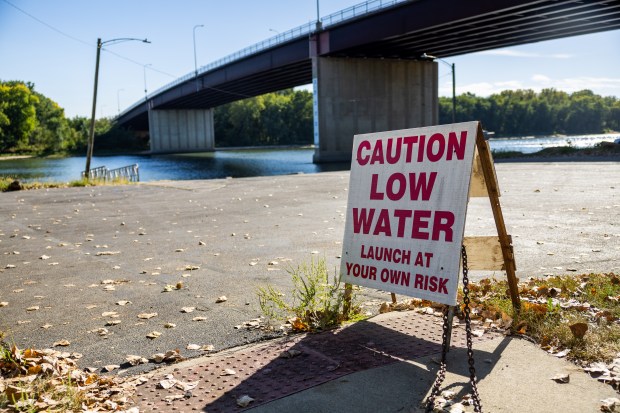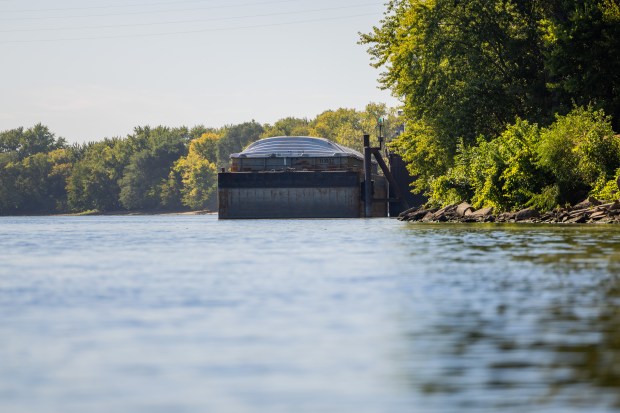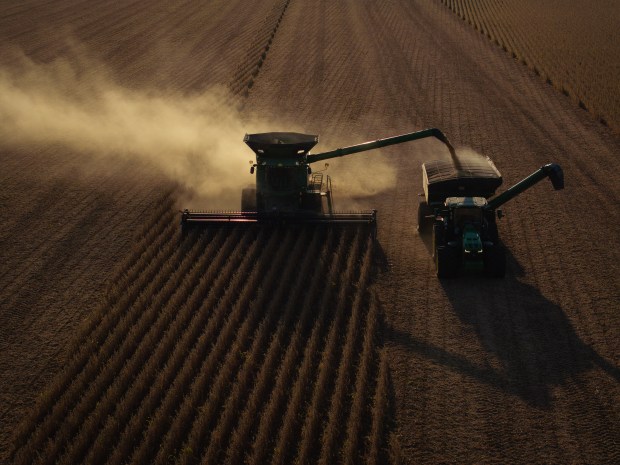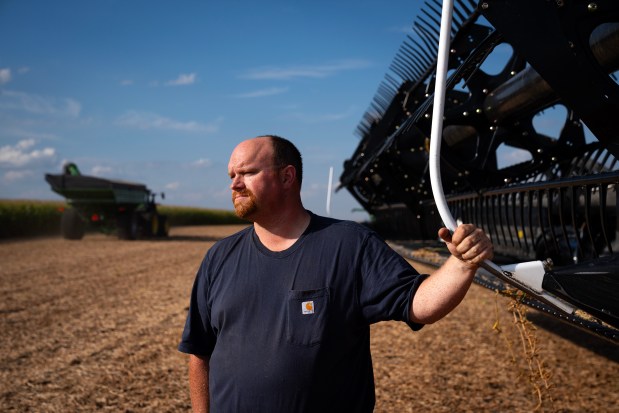Water levels in the Lower Mississippi River have dipped unusually low for a third year in a row, restricting how much grain can be transported downstream as harvest season gets underway. If levels keep dropping and barge traffic slows navigation, some Illinois farmers worry that soybean and corn prices will drop too or that they won’t be able to get fertilizer from downstream to begin prepping their fields for next year’s crops.
Concerns are bubbling up among farmers after a good growing season, since those who depend on river transport might be stuck with their product for longer than anticipated.
“Especially with a potential record number of crops coming in and no place to go,” said Jared Gregg, a seventh-generation soybean and corn farmer in Piatt County west of Champaign. “There could be folks (along the Mississippi River) that won’t be able to get harvest done until that clears out.”
Low water concerns come after Illinois experienced its third-wettest July, with a preliminary statewide precipitation total of 7.01 inches, nearly 3 inches above the 1991-2020 average. But state climatologist Trent Ford said in a recent update that the “tap shut off” during August and the first half of September. Most parts of Illinois have seen less than 2 inches of rain since the beginning of August, which is 2 to 4 inches below normal. Additionally, above-normal heat in late August and September has worsened dry conditions through more evaporation.
As whiplashing weather patterns caused by climate change intensify and average temperatures increase globally, climatologists worry these issues will persist and even worsen in the coming years.
In its most recent update Thursday, the U.S. Drought Monitor indicated that all of Illinois is now abnormally dry: 45% is being affected by at least a moderate drought and parts of a few southern Illinois counties are experiencing severe drought. Stress from dry conditions can lead to crop loss, as well as worsen pressures from disease and insects. While these conditions can work to dry crops for timely harvest, they can also increase fire risk.
Overall, this time of year typically has the lowest streamflow across the state, but the Illinois State Climatologist’s office says dry conditions have pushed levels and flow to “well below normal.” Other Mississippi tributaries like the Ohio River and nearby states like Iowa might suffer from even more significant impacts of drought.
Barges can’t transport as much product when water levels are low because they could run aground. This reduces the amount of crops that can be shipped and drives up transportation costs. With higher logistics expenses, buyers are less willing to pay market-value for products. Farmers must accept a lower bid if they want to get their crops to market and secure a profit ahead of the slow winter season.
While experts say the Illinois River has not been suffering as greatly from drought, any issues in the Lower Mississippi can still cause a barge bottleneck downstream and have ripple effects upstream. According to The Associated Press, approximately 60% of U.S. grain exports travel by barge down the Mississippi River to New Orleans.
The U.S. Department of Agriculture recorded in its most recent Grain Transportation Report that 367,468 tons of grain moved downstream for the week ending Sept. 14 — a 24% drop from 480,750 tons two weeks ago.

Illinois agricultural products on barges pass through the Mississippi in St. Louis, where the water level and streamflow are “probably indicative of what’s going on or what’s coming in from the Illinois River and the Missouri River,” according to Gary Johnson, a hydrologist and engineer at the U.S. Geological Survey’s Central Midwest Water Science Center.
The USGS gauge at the river in St. Louis recorded a “precipitous drop” in water levels in recent days, Johnson said. It was down by approximately 2 feet between midnight on Monday and Thursday afternoon, according to monitoring data collected by the USGS.
“Right now, that is below normal, yes, but it’s not way below normal,” said hydrologist Mark Fuchs with the National Weather Service office in St. Louis.
Hydrologists also look at discharge or streamflow, a measurement of the volume of water flowing by a station and how fast it’s flowing. By midafternoon Thursday, the streamflow in the Mississippi at St. Louis was 90,200 cubic feet per second compared with a historical average of 147,000 cfs in September — “that’s quite a bit less,” Johnson said. “We’re at about a little under two-thirds of the normal flow.”
But, he added, “We’ve seen worse.”
For instance, in 2012, a year of historically bad drought when barge traffic piled up due to low water levels in the Mississippi, the average streamflow at that station in September was 74,650 cfs. Last year in September, the average streamflow was 76,490 cfs — definitely worse than this year, according to Jordan Floarke, operations manager at a dry fertilizer terminal in St. Louis that receives, unloads and distributes shipments from the south. It is one of 40 regional facilities owned by the agricultural supply co-op Growmark Inc.
Some ways that barge operators deal with low water include reducing loads and the number of barges that can be towed at one time. These restrictions have been implemented down and upstream from Cairo, the southernmost city in Illinois, through Vicksburg, Mississippi, and to the Gulf of Mexico, according to a report released Wednesday by inland marine transportation company American Commercial Barge Line.
“A lighter barge means less commodity going onto that barge in itself,” Floarke told the Tribune. “With less water in the river, that makes the main channel narrower, so they can’t load the barges as heavy.”

Barges in the Lower Mississippi are currently expected to reduce loads by 400 to 600 tons, and the number of barges that can be pushed by a single vessel has been reduced, depending on horsepower, anywhere from 16 to five barges, the commercial barge line report said. A typical group of 15 barges can carry as much cargo as roughly 1,000 trucks, according to The Associated Press.
Downstream in Memphis, Tennessee, northbound traffic can typically be shut down for 24 to 48 hours to let southbound traffic through or vice versa when there’s low water, Floarke said. According to the commercial barge line, transit delays along the lower portion of the river are currently expected to last one to two days because of “reduced navigable space in certain areas.”
“That’s what we kind of have been battling the past two to three years, I would say, with the low water — our transit times,” Floarke said. “When the river’s up at a good level, we can receive a barge from New Orleans in two to two and a half weeks. But then, once we get this low river and they start with all the closures and dredging down south, we’re looking at least almost three to four weeks to receive a barge here in St. Louis.”
However, it hasn’t gotten to the point in recent years where Growmark has been unable to unload its barges. To be sure, they’ve had delays of a day or two, maybe a week, during which they’re waiting on a barge to get docked. But their setup allows them to bring a second work barge to handle material, a “blessing” other locations along the river don’t have, Floarke said.
Delays can still affect the ability of farmers upstream to receive fertilizer shipments in a timely way, something that might affect farmers like Gregg who otherwise don’t significantly depend on waterways to move their product. It’s beneficial for the following season’s crops to apply the fertilizer in the fall, he said.
“That impacts all of us,” he said, “when we can’t get barges (with fertilizer at full capacity to Illinois), especially in a prime time of application. That creates a severe bottleneck. It’s a double whammy.”

A National Weather Service river forecast indicates levels at the St. Louis station on the Mississippi might drop another foot in the next two weeks. But Fuchs noted that projection only takes into account the next 24 hours of rainfall because any forecasts beyond a day at this time of year can be highly questionable. According to a different and newer river forecast system, which accounts for the probability of rain 10 days out, it’s likely that water levels there won’t drop significantly in the near future.
“It does show that the Mississippi River in St. Louis is not really likely to fall much over the next two weeks,” Fuchs explained. “The more likely direction is an upward direction over the next couple of weeks, because of this rainfall that we’re expecting here over the next five days.”
He said northern Missouri and southern Iowa could get more than 3 inches of rain in that time.
“So we will see improvement, and there will be a sigh of relief from the navigation community for a couple of weeks, maybe a couple of weeks beyond — maybe as much as a full month of help on those two rivers,” Fuchs said.
But October tends to be a drier month, and while multiday rain events are beneficial, that benefit is limited.
“You’d like to see another event come a few days after that, on a routine basis,” Fuchs said. “And we don’t see a whole lot (of rain) coming, at least into the early part of October.”
The first thing Floarke does every day when he gets to the terminal is check river levels and projections. And he’ll keep a close eye on upcoming weather forecasts, hoping for rain. A few inches of precipitation can increase the streamflow of a river dramatically even if temporarily.
“The good thing about it is, you get one rainfall and whether it’s a half inch to an inch of rain, people don’t realize it, but that does make a world of a difference when it comes to these river terminals,” he said.
Chicago Tribune’s Karina Atkins and The Associated Press contributed.




